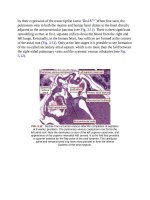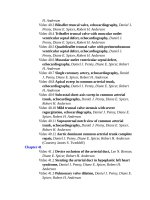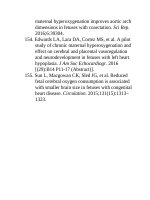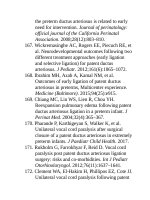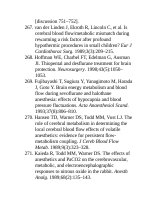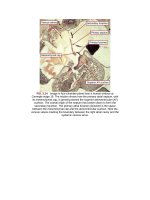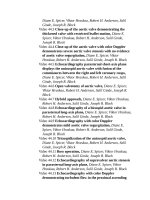Andersons pediatric cardiology 1852
Bạn đang xem bản rút gọn của tài liệu. Xem và tải ngay bản đầy đủ của tài liệu tại đây (107.82 KB, 3 trang )
DelayedSternalClosure
Neonataloperationswithalongcardiopulmonarybypasstimecanresultin
diastolicdysfunction,andsternalapproximationmayresultincardiac
compressionwithdecreaseddiastolicfillingandacriticalreductionofcardiac
output.123Anopensternumandsubsequentdelayedsternalclosureisa
frequentlyusedstrategytoamelioratepoorcardiacoutputandallowforthe
resolutionofinflammationandedemaofthemyocardiumandlungs.Itmaybe
usedinpatientswithincompletehemostasistohelppreventcardiac
tamponade.124–126Becausediastolicdysfunctionpredictablyworsensinthefirst
24hoursfollowingsurgery,delayedsternalclosureissometimesappliedtoall
neonatesfollowingcomplexoperations.Alternatively,itcanbeapplied
selectively,butuniversalcriteriadonotexist.Typicallyclosureoftheopen
sternumisundertakenwhenmobilizationofthethirdspacefluidbeginsand
vasoactivesupporthasbeenreduced.Delayedsternalclosureisassociatedwitha
prolongedCICUcourse,prolongationofintubation,andanincreasedriskof
infection.127Thisassociationislikelytheresultofdelayedsternalclosurebeing
appliedtohigher-riskpatients,butitsuggeststhatelectiveuseofdelayedsternal
closureshouldbeusedwithcaution.
AssessmentofSystemicOxygenDelivery
AssessmentofDO2inthoseatriskforshockorinshockistheprimarytenetin
thecareofcriticallyillpatients.Asdiscussedearlier,itisimportanttoappreciate
thelimitationsof“standard”hemodynamicparametersandtheperfusion
examinationindeterminingtheadequacyofQsandDO2incriticallyillpatients
andevenmoresointhosewithamultidistributioncirculation.Aneffective
constructformanagingcriticallyillpatientsistothinkofthedeterminantsof
VO2andDO2andrelationshipbetweenthem.TheuseofvenousandNIRS
oximetryisausefuladjuncttotheconventionalapproachofmonitoringstandard
clinicalparameters.Seethedetaileddiscussionofferedearlieraswellasthatin
Chapter70,astheprinciplesaresimilarinthepostoperativeperiod.
MechanicalVentilationandTransitioningto
SpontaneousVentilation
Inadditiontodeterminingwhetheradequateventilationandoxygenationare
presentonminimalventilatorysupport(lowmandatoryrateandpressure
support,end-expiratorypressureandFiO2),considerationshouldbegiventothe
factthatPPVmayhaveaprofoundimpactoncardiovascularfunction,as
describedabove.Thefollowingconditionsmaydelayextubation:ventricular
diastolicandsystolicdysfunction,theformercompoundedbyandthelatter
assistedbyPPV;residuallesions;arrhythmias;parenchymalandpleuraldisease;
lackofhemostasis;andrenaldysfunctionwithassociatedfluidimbalance.
Ausefulparadigmforconsideringextubationreadiness,particularlyinthose
thathavebeenonPPVforaprotractedperiodoftime,isconsiderationtothe
followingdeterminantsofventilatorycapacity:respiratorymuscleenergetics
(VO2/DO2),animportantfactorinthosewithalimitedQs/DO2andelevated
workofbreathing;respiratorymuscleloadingconditions,includingairway
resistanceandtotalrespiratorycompliance,thelatterconsistingoflungand
chestwallelastance(thoraciccageanddiaphragm[affectedbyabdominal
disease]);andneuromuscularcompetency,includinganassessmentof
respiratorycontrolanddrive,ensuringadequateclearanceofsedativesand
analgesics;andtheextenttowhichdisuseatrophyoftherespiratorymusclesis
present.Itisalsoimportanttoconsiderthefactthatneonateshaveconsiderably
lessrespiratoryreservethaninfantsandchildren.Thisisprimarilytheresultofa
highlycompliantthoraciccagethatdoesnotbecomecompletelyossifieduntil
about1yearofage.Relativetoinfantsandchildren,thefunctionalresidual
capacityisreduced,predisposingtheneonatetodevelopingatelectasisand
impairedoxygenation.Inaddition,thehighlycompliantchestwallprovidesless
structuralsupportinthefaceofexaggeratednegative-pressurebreathing,which
leadstoenergybeingwastedindistortingthechestwall(retractions).In
addition,theneonataldiaphragmcontainslessfatigue-resistantfibersandthe
subglotticspacehasareducedcross-sectionalarea,renderingitmoresusceptible
topostextubationlaryngealedemaandswelling.Onestrategythatmaybeused
duringtransitiontospontaneousbreathingistheempiricuseofnoninvasive
positiveairwaypressurefollowingextubation:continuouspositiveairway
pressure(CPAP)forlungvolumeandoxygenationorbiphasicpositiveairway
pressure(BiPAP)forlungvolumeandventilatoryassistance.Following
extubation,upperairwaydiseasemaybetheresultofpostextubationlaryngeal
edemaandinflammation,vocalcordparesisfrominjurytotherecurrent
laryngealnerve,unmaskingofupperairwaydisease,suchaslaryngomalaciaand
inadequateupperairwaytoneduetooversedation.
EvaluationandMonitoringoftheCentral
NervousSystem
Short-,mid-,andlonger-termoutcomestudieshaverevealedsignificant
neurodevelopmentalimpairmentinapproximatelyhalfofallsurvivorsof
neonatalsurgeryforcomplexcongenitalheartdisease(seealsoChapter76).128
Numerousmechanisms—includinginadequateDO2inthefetus,postnatal
hypoperfusion,hypoxemia,thromboembolism,andunderlyingcerebral
vasculopathy—havebeenimplicatedassomemechanismsleadingtobrain
injury.129Additionally,thebrainsofneonateswithcomplexcongenitalheart
diseaseareimmatureatthetimeofbirth,withsignificantlyalteredmetabolism,
makingthemselectivelyvulnerabletoischemicinsults;thereforeinmany
centerstheevaluationandmonitoringofthecentralnervoussystemhasbecome
aroutinepartofperioperativecareofneonateswithfUVHandothercomplex
congenitalheartdefects(Table71.6).130–132ThemodalitiesoutlinedinTable
71.6arenotmutuallyexclusiveandarepartofamultimodalevaluationofthe
centralnervoussysteminpostoperativeneonates.
Table71.6
ModalitiesforEvaluationandMonitoringoftheCentralNervous
System
Modality
Nearinfrared
spectroscopy
Timing
Advantages
Preoperative, Easybedsideinterpretation,easilyaccessible
intraoperative,
postoperative
Postoperative Detectionofsubclinicalseizures,assessmentof
corticalfunctionbyassessmentofbackground
Continuous
video
encephalography
Ultrasonography Preoperative,
postoperative
Magnetic
resonance
imaging
Preoperative,
postoperative
Disadvantages
Poorreproducibility,poor
intersubjectreliability
Resource-intense,requires
specialistinterpretation
Detectionofstructuralabnormalities,
periventricularleukomalacia,largeintracranial
hemorrhages,hydrocephalus,easilyaccessible,
performedatthebedside
Insensitiveforstroke
detection,highfalse-positive
rateforhemorrhages
Detectionofstructuralabnormalities,stroke,
hemorrhages,whitematterinjury,thrombosis,
others
Notavailableatbedside,
requiressedationinsome
(shortstudiescanbedone,as
withswaddling)
NearInfraredSpectroscopy.
NIRSisthemostwidelyusedcontinuousneuromonitoringstrategyin
